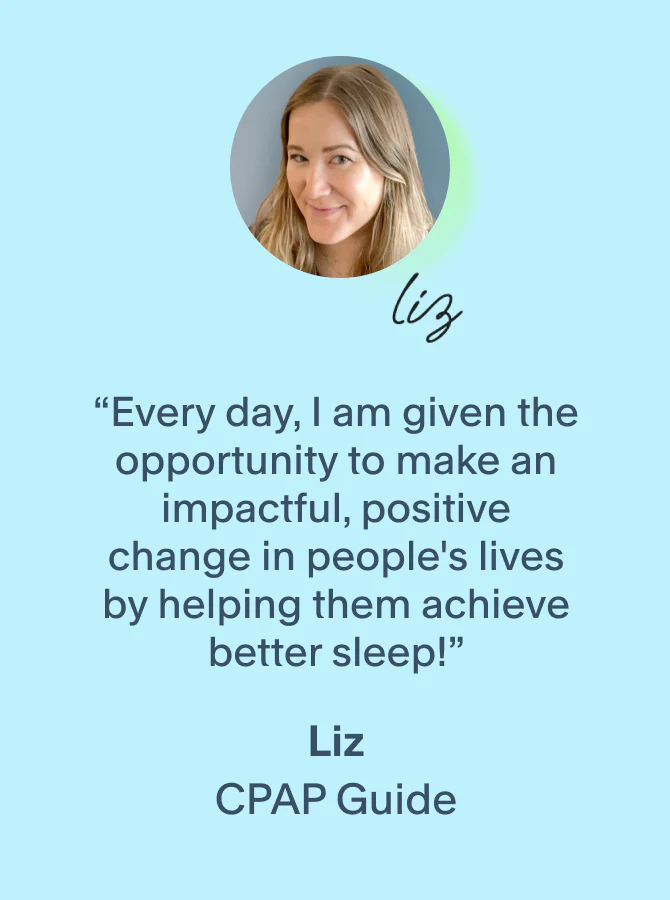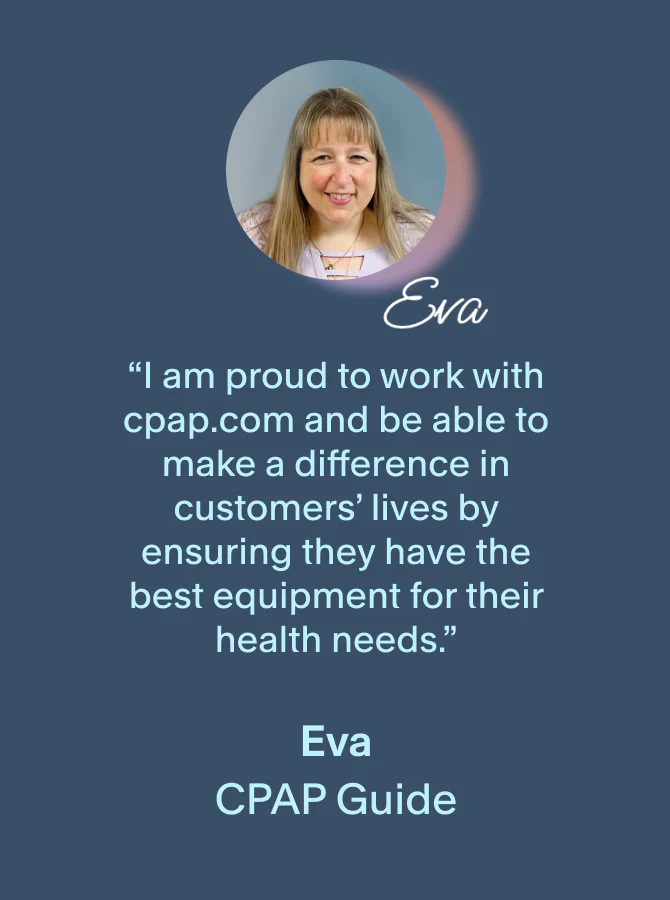Our content undergoes rigorous expert review, evidence-based research, and regular updates for accuracy.
CPAP therapy is the most effective treatment for sleep apnea. Many people who use a CPAP go on to report life-changing improvements after getting their sleep apnea under control. However, the only way to gain the full benefits of this highly effective treatment is by using your machine on a regular basis.
Like most CPAP patients, you will establish a pattern early on in your treatment. Most CPAP patients get into their patterns within the first week! To establish yours, you may have to undergo a CPAP trial that measures how often and how long you use your CPAP machine. The way this is measured is through CPAP compliance readings.
What Is CPAP Compliance?
CPAP compliance refers to whether you use your CPAP machine enough for it to be effective. To be CPAP-compliant, you must use your CPAP machine for at least 4 hours per night, 21 nights per month. Insurance companies usually require you to be compliant before covering the cost of CPAP therapy.
In some cases, your employer may also require proof of CPAP compliance in order for you to continue working. This practice is fairly common for people who fly or drive for a living, as driving with untreated sleep apnea makes you 2.5 times more likely to get into a car accident.
CPAP Compliance for Health Insurance
At first glance, it seems easy. Simply use your CPAP machine as directed. Next, go for a follow-up appointment with your doctor between the 31st and 90th day of your treatment. There, your doctor will validate your CPAP compliance by checking the machine to determine how many hours you ran the machine and the amount of time the interface was actually in use. Your doctor then sends documentation to the insurance company.
Insurance companies typically pay 80 to 90 percent of the cost of durable medical equipment, such as CPAP, after you cover the deductible. To keep costs low, though, insurance companies do not want to cover the cost of CPAP machines and equipment that you aren’t using, so they develop guidelines that define CPAP compliance.
Each insurance provider has specific requirements, but most require the use of the CPAP machine for 4 hours a night on at least 70 percent of nights. If your insurance company is like most, it will lease a CPAP machine for you for a short time. This gives you an opportunity to show that you use the equipment and that you tolerate CPAP therapy well.
The lease will likely last about 13 months, at which time your insurer will have paid off the machine, and you will own it outright.
CPAP Compliance for Employees
If you drive or fly for a living, you may need to share your compliance data with the government. You can also send your documentation to the Department of Transportation (DOT) and Federal Aviation Administration (FAA) as needed. If you drive a truck or other vehicle for a living and are at high risk for sleep apnea, you may need to submit proof that you are complying with CPAP treatment. Sleep apnea increases the risk of daytime sleepiness, which puts drivers at greater risk for accidents.
While there are currently no federal laws regarding sleep apnea during DOT physical examinations, the (FMCSA) says that professional drivers with a medical history or diagnosis that might interfere with the ability to drive must undergo successful treatment before getting behind the wheel. The Department of Transportation may use your CPAP compliance report as proof of treatment.
If you have sleep apnea and want to pilot an airplane, the FAA requires that you submit a report that shows you used your CPAP machine for at least 75 percent of sleep periods with an average minimum of 6 hours of usage per sleep period. You must also submit a signed form stating their compliance with CPAP therapy. Finally, your doctor will need to submit a form that says your treatment is still effective.
What Does Your CPAP Report Include?
There are a large number of CPAP machines now available, and they can vary by function, complexity, and price. The best CPAP machines have software that monitors certain aspects of your sleep patterns and records statistics. The results are easy to interpret, especially if you are familiar with the common readings CPAP machines typically measure. The software also makes it easy to send the data to your doctor, DOT, or FAA.
Most Common CPAP Readings
Here are some of the CPAP readings that your doctor or health insurance company may use to determine if you are CPAP compliant and if you are responding to your sleep apnea treatment plan.
AHI
Apnea Hypopnea Index (AHI) records the number of times you experience apnea and hypopnea, which occur when your airway at the back of your mouth and throat collapses. This index will take into account full closures of the airway (apneas) along with partial closures (hypopneas).
The AHI measures how many times these events occur per hour on average, which helps your doctor determine the severity of your sleep apnea.
Pressure
CPAP pressure is the amount (usually shown as an average) of air pressure delivered by the CPAP machine. Air pressure holds the airway open to prevent sleep apnea.
CPAP Leaks
A certain amount of air leakage from your CPAP mask is normal, but excessive leakage could indicate a poorly fitting mask or a mouth leak. CPAP leakage can decrease air pressure and compromise the quality of your CPAP treatment.
Usage
Usage is the amount of time you wear your CPAP mask with your CPAP machine turned on. Today’s CPAP machines can tell whether you are actually wearing the mask or if you have just turned on the CPAP machine but did not wear the mask.
Machines with basic tracking typically focus on usage but may not track AHI, pressure, or CPAP leak. Advanced CPAP machines track advanced statistics, and some contain a modem that allows you to share the results with your doctor.
The Importance of CPAP Compliance
Unfortunately, some people actually try to figure out how to cheat CPAP compliance because their jobs may depend on showing that they use their CPAP machines as directed. The truth is that they are only cheating themselves.
While it is important for insurance coverage, commercial drivers licenses, and for pilots, the most important reason to use your CPAP machine consistently and correctly is to improve your well-being. CPAP therapy can drastically improve the quality of your life.
Clearly, it is important to maintain CPAP usage. If you are like many people who are new to CPAP therapy, however, you might have trouble complying with the treatment. You might find it difficult to adapt to sleeping with the headgear on or have trouble using the CPAP machine at the right settings.
If you have trouble maintaining CPAP compliance, you are not alone. Research shows that 29 to 83 percent of patients do not meet the criteria because they remove the device early in the night, or they stop using it altogether.
Noncompliance happens for a number of reasons, but it’s absolutely critical you stick with it. Your health will improve, and you’ll experience fewer symptoms from your therapy overall. There’s no real way to cheat or fake compliance data, and there will be many benefits you’ll reap from being compliant with CPAP therapy.
You can avoid some of the pitfalls that lead to noncompliance by improving your sleep experience with a CPAP machine.
Tips to Improve Your CPAP Compliance
Here are some ways you can improve your CPAP compliance:
- Have Realistic Expectations
- Be Prepared to Make Adjustments
- Educate Yourself on CPAP Equipment
- Get the Right Equipment
- Make Sure Your Mask Seals Well
- Keep Track of Your CPAP Data
The more comfortable you make CPAP therapy, the more likely you are to use it. And, of course, the more you use your CPAP therapy, the more you will benefit from this treatment for sleep apnea.







